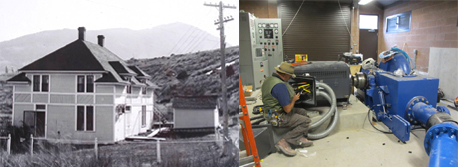-
Craig Pass Closed for the Season; Mammoth to Norris Closed Sept. 14-30
The road linking West Thumb and Old Faithful is closed for the season—traffic should detour through West Thumb, Lake, and Canyon. The road from Mammoth to Norris is closed for two weeks—traffic should detour over Dunraven Pass. More »
Yellowstone Harnesses Hydropower…Again
|

Old vs. New: The first hydropower plant located at Mammoth Hot Springs completed in 1903, and the newly constructed micro hydro system brought online last December.
NPS Photo
National Park Service Yellowstone National Park Al Nash or Dan Hottle ------------------------------------------------------------------ Yellowstone Harnesses Hydropower…Again More than a century after U.S. Army troops harnessed the power of flowing water to light Fort Yellowstone, the park is generating electricity from water again. The idea of tapping into a sustainable resource to power Yellowstone came to the park in 1903, when the U.S. Cavalry under the direction of engineer Hiram Chittenden installed the first 100-kilowatt water turbine generator near its Mammoth Hot Springs headquarters. Relying on water flowing from Glen Creek down through Golden Gate, the power plant supplied ample energy to power residences, administrative offices, maintenance shops, lights on the parade grounds and the occasional picture show at the Mammoth Hot Springs Hotel to great attendance. There was even a little left over to sell to concessioners. Commercially supplied energy has long powered the lights in Yellowstone. But a new spin on the same century-old technology is not only adding a few hundred extra kilowatts of free, home-grown power to what's already being supplied by the grid. It's also helping to reduce greenhouse gas emissions by more than 800 metric tons each year. The park's goal is to reduce greenhouse gas emissions 15 percent by 2016. Much like the 1903 hydropower plant and a second version that was constructed in Mammoth in 1911, the new Mammoth micro hydro plant relies on naturally-occurring water dynamics. It captures energy from the water that flows approximately 560 feet downhill from the combined Gardner River, Panther Creek and Indian Creek water intakes on Swan Lake Flats to the existing storage reservoir at Mammoth's water treatment plant through an existing 12-inch pipe. A newly-installed generator and turbine rely on an average water flow volume of 4 cubic feet per second to produce electricity. Construction on the electrical station housing the new generator and turbine at the reservoir inlet was completed by Montana-based Dick Anderson Construction. The power plant was officially brought on line last December. The new plant is expected to generate an average of 175 kilowatts of energy depending on the normal fluctuation of the water supply, though it is capable of producing up to 230 kilowatts. Based on an "up-time" of 80 percent (20 percent calculated for maintenance down time), that equates to more than 1.2 million kilowatt hours supplied to the park each year. The new technology also allows for this fully sustainable energy source to be synchronized directly with Northwestern Energy's electric grid, providing a savings to the park's electrical bill of approximately $73,000 annually. The project was funded by American Recovery and Reinvestment Act (ARRA) funds at a cost of $1.1 million and is expected to pay for itself in about 12 years. One hundred years ago, Chittenden's ingenious, independent green power source provided valuable energy to Yellowstone residents' homes and workspaces. Now that nostalgic thinking is working to ease Yellowstone's energy consumption and help preserve the park's valuable natural resources for generations to come. And even help power a few picture shows now and then. - www.nps.gov/yell - Follow YellowstoneNPS on YouTube Facebook Twitter Flickr |
Did You Know?

Yellowstone contains approximately one-half of the world’s hydrothermal features. There are over 10,000 hydrothermal features, including over 300 geysers, in the park.
